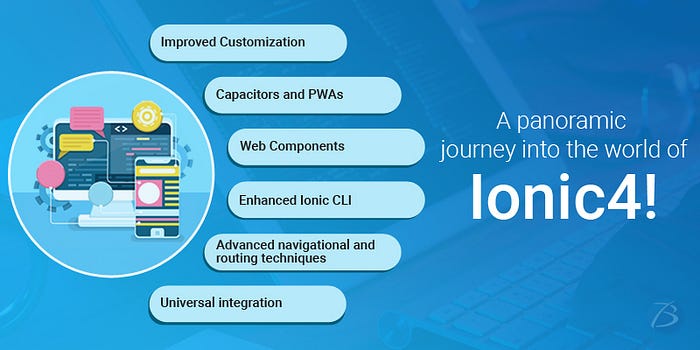
Ionic4, the most recent version of Ionic, launched in the year 2019, is popularly known as ‘Ionic for everyone.’ It is packed with goodies and has garnered loads of praise and acceptance in the software world. Ionic had originated in 2013, as a Software Development Kit intended to architect mobile apps with AngularJS. The newest version, Ionic4 built on advanced versions of Angular is compatible across all devices, platforms, and developer frameworks as it has been rebuilt using open-ended web standards. It surpasses the previous versions owing to its universal approach.
Ionic’s metamorphosis from ‘Mobile for Angular’ to ‘Ionic for everyone’ was not an easy journey. Software professionals toiled hard for two long years to conquer the limitations encountered by the existing versions and had to reinvent the wheel for best results. Finally, they succeeded in their mission to create a flawless end-product, named Ionic4. This release has sky-rocketed the demand for Ionic App Development Services. Many of you must be curious to know about the offerings of Ionic4.
This write-up will introduce you to this exemplary technology; provide comprehensive insights on its striking new features and tips on implementing them.
So, let’s get started!
The fascinating features of Ionic4
Let’s take a glance at the new and advanced features of Ionic4.
Improved Customization
Ionic4 offers CSS Custom Properties that exposes public theme API which enables the ionic developers to customize ionic components without having compatibility issues. These properties allow to theme the ionic apps regardless of the framework used in the frontend for the app. This helps in improving the modification process for styles thereby allowing the developers to upgrade to new versions of styles easily.
Capacitors and PWAs
In Ionic4, Capacitors replace the erstwhile Cordova plugins. Capacitors are runtimes for cross-platform applications that allow access to the native functions to make the web app run on Android, iOS, the web, and Electron. They also detect the platform automatically and decide the course of action based on it. They provide backward compatibility with Cordova.
Ionic4 has completely adopted PWA s (Progressive Web Apps) that provide access to native smartphone features such as camera, home screen icon, offline mode, and many more.
Web Components
Web components refer to the APIs for the web platform that enables the creation of reusable, custom, and enclosed HTML tags to be used in web applications and web pages. As these components are the part of the browser, they do not require any framework or external library. A tool named Stencil based on TypeScript was created and made open-source for this purpose. Stencil.js library compiles web components to create Progressive Web Applications and reusable UI elements, relatively faster.
Enhanced Ionic CLI
The new upgraded CLI makes it possible for the Ionic developers to make use of console commands for creating new pages, directives, components, and services, resulting in a speedy development. This CLI are designed to work with Angular CLI to get the best features from both.
Advanced navigational and routing techniques
Navigation is a key factor that defines UX. The earlier Ionic versions used a simple stack, wherein the new pages used to be pushed up the stack and for navigating backward, the last page used to be popped. Ionic4, on the other hand, enables the functioning of numerous navigational stacks simultaneously. For instance, the user can navigate using tabs on a page and at the same time navigate on another page with the help of the side menu. The reason is Ionic4 leverages the navigational life-cycles of Angular7, which leads to the auto-creation of an app-routing module.
Universal integration
Ionic4 integrates with and supports all platforms and frameworks as the components of this framework are enveloped as Web components. For example, the CLI s of Angular7, Vue.js and React are compatible with Ionic4. Furthermore, the official tools of your framework can be used along with Ionic4 for architecting, routing, and bundling.
Tips on upgrading to Ionic4
You must be a bit apprehensive about switching to Ionic4 as it introduces multiple new features. But the good news is that shifting from older Ionic versions to Ionic4 is much simpler than you had anticipated.
Ionic creators have written a comprehensive document that provides step-by-step guidance on migration and getting started. Apart from the Migration Guide, the availability of a set of smart tools like migration linter eases out the process. Moreover, Angular7 is easy to adopt and the Capacitors of Ionic4 possess backward compatibility with Cordova present in other Ionic versions. Owing to its compatibility with the old code, the new features can be implemented one by one as per your convenience.
Key Takeaway
Ionic4, loaded with cutting-edge features, has rekindled the market demand for an Ionic Development Company. The emergence of Ionic4 is a golden opportunity for businesses across diverse industry verticals, to expand their horizons and grow exponentially.
Planning to leverage Ionic4 and looking for an Ionic mobile app Development Company? Try, Biz4Solutions, a notable mobile app development company having 9+ years of experience in providing premium services to clients across the globe.
























